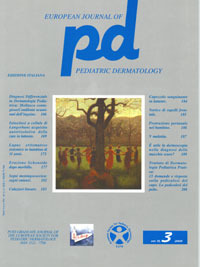Acquired self-healing Langerhans cell histiocytosis of the skin in early childhood. Case report.
Downloads
How to Cite
Yordanova I., Gospodinov D., Tsankov N., Karaivanov M., Ivanova V. 2005. Acquired self-healing Langerhans cell histiocytosis of the skin in early childhood. Case report. Eur. J. Pediat. Dermatol. 15 (3):169-72.
pp. 169-172
Abstract
Langerhans cell histiocytosis is a rare idiopathic disorder characterized by proliferation of specialized bone-marrow derived Langerhans cells. A three months breast-fed child presented from the age of two months widespread small red-brownish papules, erosions and crusts on the scalp, face, chest, back and extremities. The initial diagnosis of the disease was seborrheic dermatitis. Hepatomegaly, splenomegaly and lymphadenopathy were absent. On X-ray examination the lungs and bones were not affected. Light microscopy examination of the skin (HE, PAS) showed a histiocytic infiltrate in the papillary dermis with epidermotropism. The immunohistochemical examination demonstrated S100+, lysozyme- and CD68- dendritic cells in the infiltrate. Electron microscopy examination revealed specific Birbeck granules in these cells. After one month treatment with topical corticosteroids and emollients the lesions regressed. Because of the clinical features and the results of the light microscopy, immunohistochemical and electronmicroscopic examinations of the skin, the case here reported should be considered an acquired self-healing Langerhans cell histiocytosis. However, the patient is carefully followed up to detect a possible relapse or progression of the disease.Keywords
Langerhans cell histiocytosis, Birbeck granules, Protein S100

